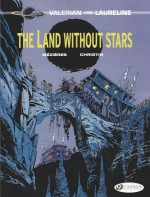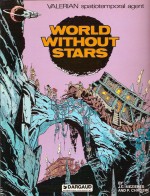
By Méziéres & Christin, with colours by E. Tranlé and translated by Jerome Saincantin (Cinebook)
ISBN: 978-1-84918-087-0Â Â (Dargaud edition) 2-205-06573-4
Val̩rian is the most influential science fiction comics series ever drawn Рand yes, that includes even Buck Rogers, Flash Gordon, Dan Dare and Judge Dredd.
Although to a large extent those venerable strips defined and later re-defined the medium itself, anybody who has seen a Star Wars movie has been exposed to doses of Jean-Claude Méziéres & Pierre Christin’s brilliant imaginings which the filmic phenomenon has shamelessly plundered for decades: everything from the character and look of alien races and cultures to the design of the Millennium Falcon and even Leia‘s Slave Girl outfit …
Simply put, more carbon-based lifeforms have experienced and marvelled at the uniquely innovative, grungy, lived-in tech realism and light-hearted swashbuckling rollercoaster romps of Méziéres & Christin than any other cartoon spacer.
The groundbreaking series followed a Franco-Belgian mini-boom in fantasy fiction triggered by Jean-Claude Forest’s 1962 creation Barbarella. Valérian: Spatio-Temporal Agent launched in the November 9th, 1967 edition of Pilote (#420) and was an instant hit. In combination with Greg & Eddy Paape’s Luc Orient and Philippe Druillet’s Lone Sloane, Valérian‘s hot public reception led to the creation of dedicated adult graphic sci-fi magazine Métal Hurlant in 1977.
Val̩rian and Laureline (as the series eventually became) is a light-hearted, wildly imaginative time-travelling, space-warping fantasy teeming with wry, satirical, humanist action and political commentary, starring Рin the early days at least Рan affable, capable, unimaginative and by-the-book cop tasked with protecting the official universal chronology by counteracting paradoxes caused by casual time-travellers.
When Valérian travelled to 11th century France in the initial tale ‘Les Mauvais Rêves (‘Bad Dreams’ and still not translated to English yet) he was rescued from doom by a fiery, capable young woman named Laureline whom he brought back to the 28th century super-citadel and administrative capital of the Terran Empire, Galaxity. The indomitable lass subsequently trained as a Spatio-Temporal operative and began accompanying him on his missions.
Every subsequent Valérian adventure until the 13th was initially serialised weekly in Pilote until the conclusion of ‘The Rage of Hypsis’ after which the mind-boggling yarns were only published as all-new complete graphic novels, until the whole spectacular saga resolved and ended in 2010.
The Land Without Stars originally ran in Pilote #570-592 (October 8th 1970 to March 11th 1971) and followed the Spatio-Temporal agents as they went about a tedious pro forma inspection of a cluster of new Terran colonies in the Ukbar star-sytem at the very edge of inter-galactic space…
However the mission soon goes awry when a wandering world is detected on a collision course with the system and Valerian, still suffering the effects of too much local alcoholic “diplomatic protocol†decides that they should investigate at close quarters…
Despite being pickled, the lead agent lands with his long-suffering assistant on the runaway planet and discovers that the celestial maverick is hollow. Moreover, a thriving ancient culture or three dwell there, utterly unaware that they are not the only beings in all of creation…
Typically however of sentient beings everywhere, two of the civilisations are locked in a millennia old war, armed and supplied by the third…
After an accident wrecks their exploratory scout ship Valerian and Laureline deduce that the constant warfare originally caused the hollow world to tumble unchecked through space and will eventually cause its complete destruction, so in short order the professional meddlers split up to infiltrate the warring nations of Malka and Valsennar.
However they are in for a surprise since both city-states are divided on gender grounds, with Malka home to prodigious warrior women who subjugate their effete and feeble males whilst the aristocratically foppish but deadly dandies of Valsennar delight in beautiful, proficient and lethally lovely ladies – but only as compliant servants…
The highly trained Galaxity operatives quickly rise in the ranks of each court – from slaves and toys to perfectly placed, trusted servants – and soon have ample opportunity to change the nature of the doomed civilisations within the collision-course world, after which the heroes even concoct a canny and cunning method of spectacularly ceasing the planet’s random perambulations; giving it a stable orbit and new lease on life…
All in a days work, naturally, although it did take a few months to sort out: still what’s time to a couple of brilliant Spatio-Temporal agents?
Happily, this mind-boggling forty-year old social and sexual satire is packed with astounding action, imaginative imagery and fantastic creatures to provide zest to a plot that has since become rather overused – sure proof of the quality of this delightful, so-often imitated original yarn – but as always the space-opera is fun-filled, witty, visually breathtaking and stunningly ingenious. Drenched in wickedly wide-eyed wonderment, science fiction sagas have never been better than this.

Between 1981-1985 Dargaud-Canada and Dargaud-USA published a quartet of these albums in English (with a limited British imprint from Hodder-Dargaud in the UK) under the umbrella title Valerian: Spatiotemporal Agent and this tale, then called World Without Stars, was the second release, translated then by L. Mitchell.
Although this modern Cinebook release boasts improved print and colour values and a far better and more fluid translation, interested completists might also want to track down the 20th century releases for the added text features ‘Valerian: Graphic Renaissance’ by acclaimed SF author William Rotsler, the appreciation ‘In Science Fiction’s Net’ by French genre writer/illustrator Jean-Pierre Andrevon and the extensive biographies and work check-lists of creators Pierre Christin & Claude Méziéres…
© Dargaud Paris, 1972 Christin, Méziéres & Tran-Lệ. All rights reserved. English translation © 2012 Cinebook Ltd.
